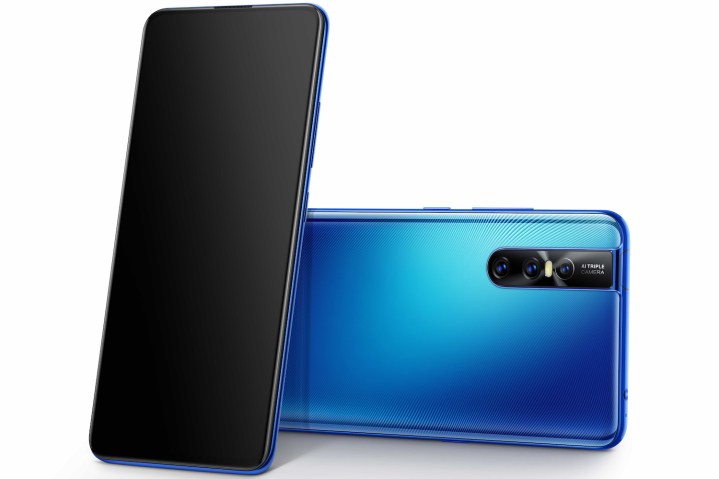 The Vivo V15 Pro has a secret: A motorized, pop-up selfie camera, and it’s the latest device announced by the Chinese device manufacturer, which is known for its innovative designs and cool camera features. Vivo introduced the motorized selfie camera on the Vivo Nex S, but the V15 Pro is going to be more modestly priced and will bring that and some other cool technology to more people.
The Vivo V15 Pro has a secret: A motorized, pop-up selfie camera, and it’s the latest device announced by the Chinese device manufacturer, which is known for its innovative designs and cool camera features. Vivo introduced the motorized selfie camera on the Vivo Nex S, but the V15 Pro is going to be more modestly priced and will bring that and some other cool technology to more people.
Why include a motorized camera? It’s to enable the V15 Pro to have a proper full-screen experience, without a notch of any kind. The 6.4-inch Super AMOLED screen has a 91.6-percent screen-to-body ratio, with tiny bezels at the top and the sides. How small? The side bezels are just 1.75mm and the top is 2.2mm. The camera emerges from the top right of the phone (from the front) and contains a 32-megapixel sensor, continuing Vivo’s dedication to high-quality selfies.
On the back is a triple-lens camera which contains a 48-megapixel sensor, just like we’ve seen on the Honor View 20. It’s joined by an 8-megapixel, 120-degree wide-angle camera, and a 5-megapixel depth-sensing camera. Both the front and rear cams are loaded with artificial intelligence features, from face and body beauty modes to scene recognition, and a night mode. The camera also suggests when the wide-angle camera would enhance a photo, based on the scene.

How about the internal technology? This is a midrange smartphone with a Qualcomm Snapdragon 675 processor, supported by 8GB of RAM and 128GB of internal storage. Oddly, while the V15 Pro does have a MicroSD card slot, it’s located on the side of the phone, rather than being part of the SIM tray which is found on the bottom of the phone. It’s also charged using a Micro USB port, rather than a newer USB Type-C. Google Android 9.0 Pie runs on the phone, with Vivo’s own Funtouch OS 9 user interface over the top.
What else? There is a dedicated button on the side of the phone to call Google Assistant, a new fifth-generation in-display fingerprint sensor for security, face recognition, and Bluetooth 5.0. The body is made from plastic, but comes in a fantastic blue color, and weighs 185 grams. It’s just 8.21mm thick.
Vivo announced the V15 Pro for its global markets and for China, with India being the first stop for the device. It will not be officially released in the U.S., but may be purchased as an import. Vivo has not confirmed the release date or the price. We’ll update here when these details are announced.



